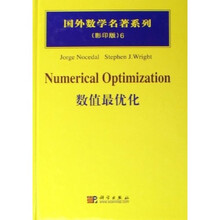国外数学名著系列:数值最优化(影印版)

目 录内容简介
Part I Problems and Tricks
1 Elementary Number Theory
1.1 Problems About Primes. Divisibility and Primality
1.2 Diophantine Equations of Degree One and Two
1.3 Cubic Diophantine Equations
1.4 Approximations and Continued Fractions
1.5 Diophantine Approximation and the Irrationality
2 Some Applications of Elementary Number Theory
2.1 Factorization and Public Key Cryptosystems
2.2 Deterministic Primality Tests
2.3 Factorization of Large Integers
Part II Ideas and Theories
3 Induction and Recursion
3.1 Elementary Number Theory From the Point of View of Logic
3.2 Diophantine Sets
3.3 Partially Recursive Functions and Enumerable Sets
3.4 Diophantineness of a Set and algorithmic Undecidability
4 Arithmetic of algebraic numbers
4.1 Algebraic Numbers: Their Realizations and Geometry
4.2 Decomposition of Prime Ideals, Dedekind Domains, and Valuations
4.3 Local and Global Methods
4.4 Class Field Theory
4.5 Galois Group in Arithetical Problems
5 Arithmetic of algebraic varieties
5.1 Arithmetic Varieties and Basic Notions of Algebraic Geometry
5.2 Geometric Notions in the Study of Diophantine equations
5.3 Elliptic curves, Abelian Varieties, and Linear Groups
5.4 Diophantine Equations and Galois Repressentations
5.5 The Theorem of Faltings and Finiteness Problems in Diophantine Geometry
6 Zeta Functions and Modular Forms
6.1 Zeta Functions of Arithmetic Schemes
6.2 L-Functions, the Theory of Tate and Explicite Formulae
6.3 Modular Forms and Euler Products
6.4 Modular Forms and Galois Representations
6.5 Automorphic Forms and The Langlands Program
7 Fermats Last Theorem and Families of Modular Forms
7.1 Shimura-Taniyama-Weil Conjecture and Reciprocity Laws
7.2 Theorem of Langlands-Tunnell and Modularity Modulo 3
7.3 Modularity of Galois representations and Universal Deformation Rings
7.4 Wiles Main Theorem and Isomorphism Criteria for Local Rings
7.5 Wiles Induction Step: Application of the Criteria and Galois Cohomology
7.6 The Relative Invariant, the Main Inequality and The Minimal Case
7.7 End of Wiles Proof and Theorem on Absolute Irreducibility
Part III Analogies and Visions
III-0 Introductory survey to part III: motivations and description
III.1 Analogies and differences between numbers and functions: 8-point, Archimedean properties etc.
III.2 Arakelov geometry, fiber over 8, cycles, Green functions (dapres Gillet-Soule)
III.3 -functions, local factors at 8, Serres T-factors
III.4 A guess that the missing geometric objects are noncommutative spaces
8 Arakelov Geometry and Noncommutative Geometry
8.1 Schottky Uniformization and Arakelov Geometry
8.2 Cohomological Constructions
8.3 Spectral Triples, Dynamics and Zeta Functions
8.4 Reduction mod 8
References
Index
1 Elementary Number Theory
1.1 Problems About Primes. Divisibility and Primality
1.2 Diophantine Equations of Degree One and Two
1.3 Cubic Diophantine Equations
1.4 Approximations and Continued Fractions
1.5 Diophantine Approximation and the Irrationality
2 Some Applications of Elementary Number Theory
2.1 Factorization and Public Key Cryptosystems
2.2 Deterministic Primality Tests
2.3 Factorization of Large Integers
Part II Ideas and Theories
3 Induction and Recursion
3.1 Elementary Number Theory From the Point of View of Logic
3.2 Diophantine Sets
3.3 Partially Recursive Functions and Enumerable Sets
3.4 Diophantineness of a Set and algorithmic Undecidability
4 Arithmetic of algebraic numbers
4.1 Algebraic Numbers: Their Realizations and Geometry
4.2 Decomposition of Prime Ideals, Dedekind Domains, and Valuations
4.3 Local and Global Methods
4.4 Class Field Theory
4.5 Galois Group in Arithetical Problems
5 Arithmetic of algebraic varieties
5.1 Arithmetic Varieties and Basic Notions of Algebraic Geometry
5.2 Geometric Notions in the Study of Diophantine equations
5.3 Elliptic curves, Abelian Varieties, and Linear Groups
5.4 Diophantine Equations and Galois Repressentations
5.5 The Theorem of Faltings and Finiteness Problems in Diophantine Geometry
6 Zeta Functions and Modular Forms
6.1 Zeta Functions of Arithmetic Schemes
6.2 L-Functions, the Theory of Tate and Explicite Formulae
6.3 Modular Forms and Euler Products
6.4 Modular Forms and Galois Representations
6.5 Automorphic Forms and The Langlands Program
7 Fermats Last Theorem and Families of Modular Forms
7.1 Shimura-Taniyama-Weil Conjecture and Reciprocity Laws
7.2 Theorem of Langlands-Tunnell and Modularity Modulo 3
7.3 Modularity of Galois representations and Universal Deformation Rings
7.4 Wiles Main Theorem and Isomorphism Criteria for Local Rings
7.5 Wiles Induction Step: Application of the Criteria and Galois Cohomology
7.6 The Relative Invariant, the Main Inequality and The Minimal Case
7.7 End of Wiles Proof and Theorem on Absolute Irreducibility
Part III Analogies and Visions
III-0 Introductory survey to part III: motivations and description
III.1 Analogies and differences between numbers and functions: 8-point, Archimedean properties etc.
III.2 Arakelov geometry, fiber over 8, cycles, Green functions (dapres Gillet-Soule)
III.3 -functions, local factors at 8, Serres T-factors
III.4 A guess that the missing geometric objects are noncommutative spaces
8 Arakelov Geometry and Noncommutative Geometry
8.1 Schottky Uniformization and Arakelov Geometry
8.2 Cohomological Constructions
8.3 Spectral Triples, Dynamics and Zeta Functions
8.4 Reduction mod 8
References
Index
目 录内容简介
本书提供优化中大多数有效方法的全面的新的论述。每一章从基本概念开始,逐步阐述当前可用的优秀技术。
比价列表
公众号、微信群
 缺书网
缺书网微信公众号
 扫码进群
扫码进群实时获取购书优惠






